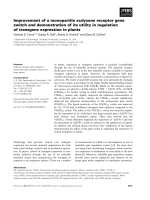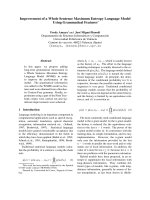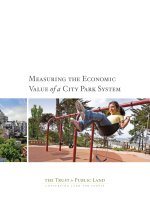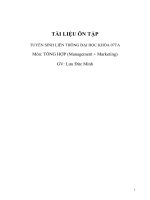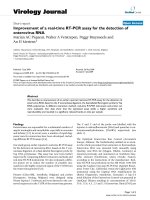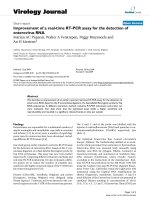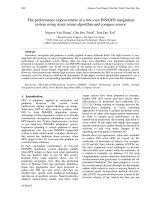Vũ Đức Minh. Improvement of traffic management efficiency in transport zones of a city
Bạn đang xem bản rút gọn của tài liệu. Xem và tải ngay bản đầy đủ của tài liệu tại đây (223.67 KB, 6 trang )
ABSTRACT
Vũ Đức Minh. Improvement of traffic management efficiency in transport
zones of a city. – Qualifying scientific work on the rights of the manuscript.
Thesis for obtaining the degree of doctor of philosophy in the specialty 275.03
– Transport Technologies (on Road Transport). – Kharkiv National Automobile and
Highway University, Ministry of Education and Science of Ukraine, Kharkiv, 2021.
The dissertation is devoted to the solution of the applied scientific problem of
the estimation of the influence of complicated traffic conditions on vehicle speed
and determination of the distribution of the vehicle speed on urban street networks.
To solve the problem, the existing methods to model transport flows and
estimate vehicle speed on an urban street network as well as estimate vehicle delays
caused by traffic management were analysed. It allowed defining that most of the
existing approaches to predict vehicle speed implies determining its average value
at some point or a short road section in any traffic conditions. The same approach is
applied in modern transport modelling software, but it is obvious that the speed of a
vehicle at a specific place and time is random. In addition, vehicle speed in urban
traffic conditions is influenced by the intersections, especially signalized ones, and
other obstructions of traffic causing speed decreasing. It points to the need for the
study of vehicle speed in a city as the random variable and, correspondingly, the
determination of its distribution law.
One of the data sources for this speed study was the traffic flows macromodelling for relatively small but loaded areas which are the road networks in the
centres of Kharkiv and Hanoi. To adequately represent the speed of traffic flows
between the transport attractors located along the streets in the city centres, a new
approach to traffic assignment based on vehicle delays at intersections was
developed. This approach made it possible to represent traffic flow parameters more
precisely compared to the existing most widespread traffic assignment method based
on the road network link capacities and take into account private transport delays at
signalized intersections during estimation of the travel speed between transport
attractors. Modelling of the traffic flows and a comparative assessment of the
mentioned urban traffic assignment methods was carried out in the PTV® VISUM
software since it provides tools that best reveal the features of each calculation
method. At the same time, the comparison of alternative methods with the use of the
real transport models provided the possibility to compare calculated traffic volumes
with actual ones and brought the scientific problem under the study close to the
problems arising in modelling practice.
Further study of the speed as a random variable made it possible to define that
under the most difficult driving conditions, normal vehicle speed distribution
changes to an exponential one. The gamma distribution was used as a connecting
link in the transformation of the normal distribution into an exponential one under
traffic conditions complication since the exponential distribution is the special case
of gamma distribution with the shape parameter equal to 1, and the normal
distribution is the limiting case of gamma distribution with the shape parameter
tending to infinity.
To experimentally confirm the possibility of the use of the gamma
distribution, the car speed influenced by the narrow carriageway was studied. This
type of traffic conditions complication can be considered a kind of transition from a
free flow to the complicated conditions caused by signalized intersections. It leads
to a decrease in vehicle speed. However, it is not an extreme case of speed decreasing
since it does not require a mandatory full stop of a vehicle– most drivers only need
to reduce the speed without a full stop.
As for testing the possibility to use the exponential distribution when
describing the speed under a significant traffic conditions complication, this
hypothesis was confirmed during observations in the most difficult conditions in
terms of speed – in the zones of influence of signalized intersections. The zone
before the stop-line of signalized intersection causes traffic conditions that are a
priori more complicated compared to carriageway narrowing because at this zone
some drivers must stop and wait for the green signal.
During the study of the vehicle speed before the stop line of the intersection,
it was necessary to take into account the possible vehicles delays caused by waiting
for the green. To take these waiting times into account during the speed
measurement, a new methodology was developed. According to this methodology,
the speed was measured in the cross-section at 1.5 m before the stop-line. It allowed
the body of the first car in a queue to always be in the cross-section during waiting
for the green signal. Upon that, the distance for which the time of passing the crosssection was measured was a car length. To make these measurements, two points of
time was being recorded – when the considered cross-section was crossed by the
front and rear points of a car. Also, a car length was being recorded – it was the
distance between these points.
The analysis of measurements made according to the presented methodology
allowed defining that the signalized intersection complicates the traffic conditions
significantly compared to the narrow carriageway. This was reflected in a decrease
in the average vehicle speed and an increase in speed standard deviation. In total, it
causes a decrease in the shape parameter of the gamma distribution and, as a result,
it tends to one. Based on the processed measurement results, the possibility to
describe the random variable of the vehicle speed using an exponential distribution
was confirmed.
The data about vehicle speed in urban areas in different countries collected
during the research made it possible to obtain the regression model reflecting the
relationship between the average speed and the shape parameter of the gamma
distribution suitable for describing the regularities in speed values. The obtained
model has sufficient predictive capability since the multiple correlation coefficient
equals 96.3%.
Based on the research results, practical recommendations to apply defined
regularities in the variable of private transport speed in cities were developed. Thus,
a method to calculate acceleration noise for the vehicles leaving the signalized
intersection on a green signal was developed based on these regularities. It allows
obtaining initial data to estimate acceleration noise as a measure of comfort and
energy consumption when driving in urban traffic flows as well as traffic
management quality. Also, a methodology to calculate the volumes of exhaust
emissions from vehicles was developed, and it makes it possible interval assessment
of the environmental impact of traffic flows and provides the tools for a comparative
analysis of the changes in urban transport systems.
The developed recommendations and methods were applied during traffic
flows modelling for the Long Biên district in Hanoi city and assessing the road
network performance under different traffic conditions. Two options of traffic
management in the district were considered – the current network state and the state
with the rational traffic signal cycles at all signalized intersections in the district.
These changes relate to the most loaded part of the road network as well as make it
possible to evaluate the practicability of the developed methods and the effectiveness
of the proposed recommendations. If the proposed traffic signal cycles are used, then
total vehicle delays at signalized intersections in the Long Bien district should
decrease by 12.47%, the average vehicle speed between transport attractors should
increase by 0.55%, exhaust emissions should decrease by 0.56%, acceleration noise
should decrease by 5.88%. It confirms the feasibility of the use of new methods for
a comprehensive assessment of urban transport networks performance.
The scientific novelty of the obtained results is as follows:
- for the first time the influence of complicated urban traffic conditions on the
car speed, which allows, in contrast to known approaches, determining the type of
car speed distribution for the urban street network is established;
- for the first time a new approach to estimate the parameters of car speed
distribution in cities which allows obtaining these parameters based on the average
speed and, in contrast to known approaches, characterizing the speed as a random
variable with the distribution law suitable for its description.
Methods to estimate the vehicle speed are improved due to determining the
speed on the basis of the time for passing the distance equal to vehicle length, It, in
contrast to known approaches, makes it possible to directly take into account the
vehicle delays at intersections during speed measurements.
The practical significance of the research results consists in the development
of the methodology to measure the vehicle speed before the stop line of an urban
signalized intersection, the approach to traffic assignment for urban networks based
on vehicle delays at intersections as well as the methodology to estimate acceleration
noise for the vehicles leaving the intersection on the green signal.
Keywords: speed distribution, car speed, signalized intersection, narrow
carriageway, traffic conditions, traffic flow, transport modelling.
List of candidate’s publications
Scientific papers in which the main scientific results of the thesis are
published:
1. Lobashov A.O., Vu Duc Minh. Method to predicting traffic flows behaviour
in cities. Bulletin of the Kharkiv National Automobile and Highway University.
2002. № 18. P. 77–79.
2. Makarychev O., Horbachov P., Vũ Đức Minh, Horbachova O. Car speed
distribution in front of a stop-line of urban regulated intersection. Bulletin of the
Kharkiv National Automobile and Highway University. 2019. № 85. P. 107–116.
3. Vũ Đức Minh, Horbachov P., Kolii O., Svichynskyi S. Urban traffic
assignment based on signalized intersection delays. Automobile transport. 2020. №
46. P. 47–62.
4. Horbachov P., Vũ Đức Minh, Svichynskyi S., Shtanko I. The Changes in
Vehicle Speed Distribution Related to Complicated Traffic Conditions in Cities.
Transport, Ecology – Sustainable Development: Proceedings of the technical and
scientific conference ECO Varna (Varna, 13-15 May 2021). Varna, 2021. P. 34–43.
5. Vũ Đức Minh. Approach to estimating acceleration noise based on average
vehicle speed. Bulletin of Kherson National Technical University. 2021. № 3(78). P.
27–35.
Scientific works certifying the testing of the dissertation materials:
6. Vũ Đức Minh, Horbachov P., Kolii O., Svichynskyi S. An approach to
urban traffic assignment based on the parameters of traffic signal cycles. Problems
and prospects of automobile transport: materials of the VIII Int. sc. and pract.
internet-conf. (April 14-15, 2020). Vinnytsya, 2020. P. 98–102.
7. Horbachov P., Vũ Đức Minh, Svichynskyi S. The research of the
distribution of the car speed before the stop-line of signalized intersection.
Innovation technologies for the development of machinery and efficient functioning
of transport systems: proceedings of the II All-Ukrainian sc. and tech. internet-conf.
(November 9-11, 2020). Rivne, 2020. P. 34–36.
8. Horbachov P., Vũ Đức Minh, Svichynskyi S. The methodology for
measuring the vehicles’ speed before the stop line of a signalized intersection.
Modern tendencies in the development of machinery and transport: materials of the
7-th Int. sc. and tech. conf. (November 11-13, 2020). Kremenchuk, 2020. P. 86–87.
9. Vũ Đức Minh, Svichynskyi S. The influence of city signalized intersections
on the motorbike speed distribution. The trends in the development of technological
systems and logistics in AC: materials of the ІІІ Int. sc. and pract. internet-conf.
(April 22, 2021). Kharkiv, 2021. P. 96–98.
Scientific works which additionally reflect the scientific results of the
dissertation:
10. New approach to develop static signal cycles for urban street intersections:
certificate of the registration of the author rights to the paper / Horbachov P., Vũ
Đức Minh, Shevchenko V. (Ukraine). № 88689; registered on 20.05.2019.
11. Ivanov I., Vũ Đức Minh, Svichynskyi S. Features of the design of the
sample mobility survey in city. Innovation technologies for the development of
machinery and efficient functioning of transport systems: proceedings of the AllUkrainian sc. and tech. internet-conf. (November 28-29, 2019). Rivne, 2019. P. 53–
55.
12. Horbachov P., Vũ Đức Minh, Shtanko І. Distribution regularities of motor
vehicle speed on city streets. Modern information systems. 2020. №. 4(2). P. 163–
169.

